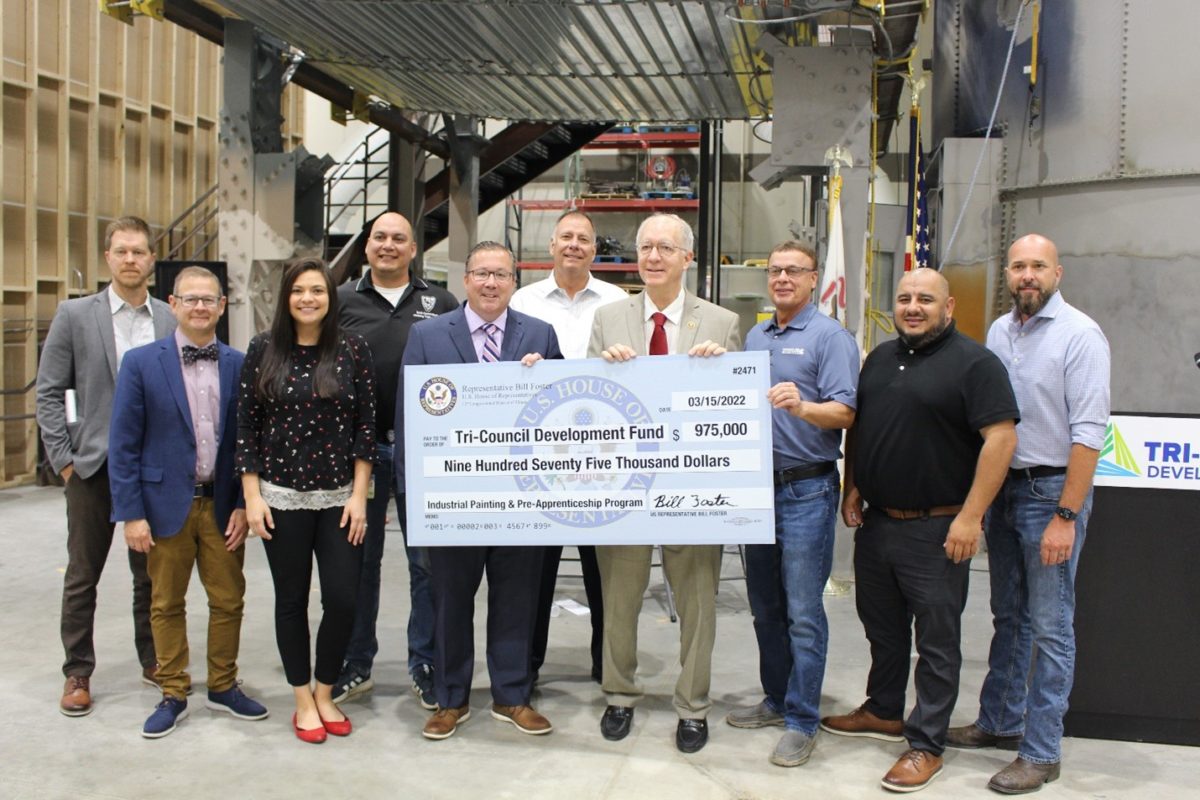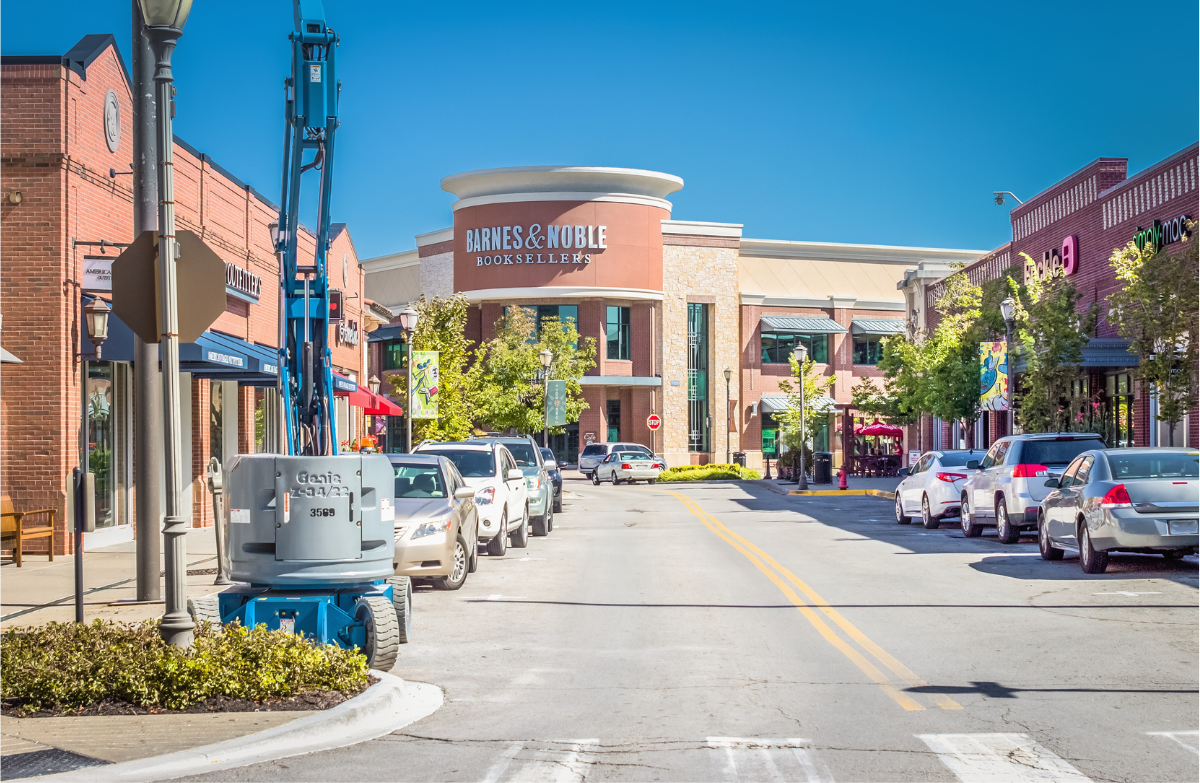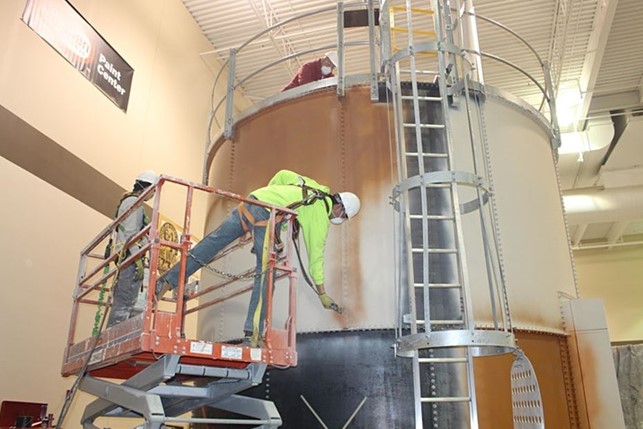TCDF LAUNCHES NEW WORKFORCE DEVELOPMENT PROGRAM
June 23, 2022

The TCDF has launched a new Industrial Painting Pre-apprenticeship program that will help keep Illinois’ community infrastructure strong while providing valuable training and life skills to apprentice candidates.
Made possible through a federal Community Project Funding award of $975,000 included in the Consolidated Appropriations Act signed into law by President Biden in March, the Industrial Painting Pre-apprenticeship will be a unique workforce development partnership that brings together the three apprenticeship programs in Illinois affiliated with the International Union of Painters and Allied Trades (IUPAT) to prepare the next generation of Illinois’ industrial painters.
Representatives from the TCDF’s partnering IUPAT district councils and their affiliated contractor associations gathered at the Aurora-based North Central Illinois Finishing Trades Institute on June 17 to announce the receipt of the award. U.S. Representative Bill Foster carried the funding proposal in Washington and was on hand to launch the program, which is being sponsored by the TCDF.
“This is a story about training the next generation of painters needed to care for our vital infrastructure,” said TCDF executive director, Todd Dotson, at the launch event. “We wouldn’t be able to tell that story were it not for Representative Foster’s willingness to learn about the training needs in the industrial painting sector and how workforce development in this area is an essential part of maintaining and improving our state’s infrastructure.”
Speakers at the event outlined the need for repair, replacement, and upgrades to public infrastructure systems of all types, and how demand for industrial painting work and workers is expected to grow rapidly. In Illinois alone, Dotson reported in his remarks, the American Society of Civil Engineers recently found that more than $27 billion was needed for maintenance, repair, and upgrades to public drinking water and wastewater systems and that more than 2,400 bridges across the state were structurally deficient.
Representative Foster emphasized the critical role of training to keep up with technological advancements and create career opportunities. “The future of work will look much different from what we remember growing up,” noted Foster. “We need to invest in training and apprenticeship programs that enhance and expand people’s marketable skills, opening doors to the types of jobs that can support families and allow people to build secure lives. The TCDF is a critical component of just that. In partnership with the Illinois union finishing trades industries, they’re helping to strengthen our middle class while expanding opportunities to enter trade careers.”
Stephen Lefaver, Director of the North Central Illinois Finishing Trades Institute, one of three union apprenticeship programs that train industrial painters in Illinois, described industrial painting as “the most challenging painting work performed in the finishing industry,” adding that it is “highly specialized work that should be performed only by trained protective coatings specialists.” This includes, according to Lefaver, training in scaffolding and rigging, the science of corrosion, the use of high-powered blasting equipment, the application of specialized coatings, and health and safety protocols to keep themselves, their coworkers, and the public safe when the work is being performed.
The industrial painting sector is a complex segment of the finishing trades that focuses on applying industrial coatings to steel and concrete surfaces, such as those found in bridges, water towers, treatment plants, and many other types of vital community infrastructure. The funding will enable the TCDF, in partnership with the IUPAT training centers, located in Chicago, Aurora, and Collinsville, Illinois to provide career readiness training free of charge for as many as 100 students.
The program partners are also committed to working with community organizations to identify minority and female job seekers and members of other historically underserved or underrepresented populations who might wish to consider the industrial painting trades as a career.
“In designing the program, we plan to devote a significant amount of the funding to student support, providing the resources to address significant financial barriers that often exist for those seeking to enter into the building trades workforce, helping them thrive during the early days as an apprentice and get on a path to long-term employment,” says Dotson. Support for costs associated with transportation and childcare and stipends for time spent in the program are examples of the type of support Dotson says are needed while participants learn whether industrial painting is a career they can thrive in.
Dotson is excited to launch the program: “The IPP will help build workforce bench strength in the industrial sector to ensure that these critical community projects get done right and on time and budget. This program is a win-win-win for workers, contractors, and communities.”

Market insights you can use, delivered in a single bite.
Retail Sector
Already battered by consumers’ historic pivot to online shopping, few other sectors of the construction economy were pummeled as much by the effects of pandemic lockdown and its aftermath as bricks-and-mortar retail. As shopping districts – particularly those dependent on daytime office traffic – emptied out and consumers withdrew ever farther into their insular online worlds, some wondered if traditional retail was altogether doomed.
Now, however, there are new signs of growth for the sector – even as the national economy struggles to recover. The International Council of Shopping Centers, for example, recently reported that same-store sales – long a bellwether metric for the industry – rose to record levels for most retail categories in the first quarter of 2022, demonstrating a surprising sector resilience.
Rising sales volumes have led to increased leasing activity and, as a result, higher asking rents. And as available space shrinks in premier shopping corridors, we anticipate increased construction activity to follow.
In the Chicago region, according to CoStar, the overall retail vacancy rate now stands at 5.8% – down from 6.5% in late 2020. Absorption levels are also increasing, with CoStar further reporting that Chicago ranked fourth in the nation for retail move-in gain year-over-year.
According to CoStar, at the end of the first quarter there were 1.4 million square feet of retail space under construction across the Chicago Metro – double that of last year. The “glass half empty” view is that construction activity remains low by historic standards. However, the “glass half full” view is that increasing in-store activity and relatively low supply will mean increasing near- and longer-term demand for new retail construction as the economy stabilizes and strengthens.

In late 2021, the TCDF’s Corrosion Illinois Network launched its Asset Protection Program unsure if such an innovative approach to community infrastructure protection would be embraced by communities across Illinois. Now, less than one year later, an increasing number of communities are answering a resounding YES.
Through the program, the Corrosion Illinois Network offers technical assistance and funding to Illinois’ community water systems for the creation of ten-year Asset Protection Plans. These plans include the inspection and evaluation of all water supply and wastewater treatment assets by a licensed, experienced engineering firm and the development of plans for maintenance, repair, or replacement as necessary.
In order to ensure that asset protection planning results in increased system safety and stability – and long term cost savings communities – the program requires that water system owners and operators agree to use Corrosion Illinois Network-certified contractors for all corrosion prevention and mitigation work stipulated in the plan. Contractors achieve CIN certification based on their ability and willingness to adhere to industry standards and best practices. In addition, they are required to follow all applicable state and local laws and regulations and must be affiliated with a federally accredited vocational school that offers the highly specialized training and certifications required to achieve the highest skill level in industrial coatings application.
Twelve communities across the state have already taken advantage of the program, with asset inspections and plan development now in process by engineers from Robinson Engineering. Moreover, many other communities have expressed interest and are taking steps to adopt the program for their water systems.
On the heels of its initial success, the CIN is preparing to expand the program to ensure that any community, regardless of available resources, can take advantage of it and help ensure long-term protection of its vital water system infrastructure.
“We are extremely excited about the future of this program,” said Zach Lowe, TCDF’s Director of Planning and Programming. “The initial feedback has been a strong incentive to move forward as quickly as possible. There is obviously a huge need for the services we are offering as communities become more acutely aware of the importance and challenges of protecting their infrastructure for public health, cost savings, and community growth.”
For more information on the Asset Protection Program, visit https://corrosionillinois.com/corrosion-illinois-network/.

In recent discussions with community water system operators across Illinois, the Corrosion Illinois Network (CIN) – the TCDF’s flagship infrastructure resilience initiative – found that the biggest challenges communities often face in maintaining safe and reliable drinking water and wastewater treatment systems are identifying and planning for maintenance needs and securing project funding.
Both challenges will be addressed in an upcoming “lunch and learn” program to be presented by the CIN on March 9, 2022. The program, entitled “Water Solutions,” will dive deeply into the maintenance and repair challenges familiar to water system operators and the municipal officials charged with overseeing community water systems.
The program, to be held at the Painters District Council No. 30 facility in Aurora, will include informative presentations by corrosion industry leaders on issues that impact all drinking water and wastewater systems, including the high – often hidden – costs of corrosion and what communities can do to maintain their water system assets in good working order. Additionally, the program will provide guidance and insights on how proper maintenance planning can help significantly reduce operating costs – as well as how communities can prepare to successfully apply for water system project funding.
The program is the first in a series that the CIN plans to replicate across the state. According to TCDF executive director, Todd Dotson, “These issues – maintenance and project funding – are faced by all communities, no matter how big or small. The role of the CIN is to help give communities the upper hand on corrosion, with the tools to deal with it and, ultimately, to stop it before it starts.”
Dotson notes that developing resilient water infrastructure is key to helping communities reduce water utility costs and capital expenses, safeguard public health, and position themselves for growth.
Attendees at the Water Solutions event will also enjoy opportunities to network with colleagues over coffee and lunch. Additionally, the nationally accredited North Central Illinois Finishing Trades Institute – housed in the Aurora facility – will offer tours of their state-of-the-art training facility, where teaching staff utilize sophisticated instructional tools to train finishing trades workers in the highly specialized techniques of surface preparation and industrial coatings application on steel and concrete surfaces such as those found in water towers and bridges.
This event is free, but registration is required, and space is limited. For more information and to register, visit the event registration page.
Market insights you can use, delivered in a single bite.

Single Family Rental Market
Since the advent of FHA loans and other financing tools geared toward first-time home buyers, the pattern has been the same: young apartment-dwelling adults preparing for, or just starting, families of their own give up their rented apartments to purchase single-family homes offering less density, more space, and outdoor amenities. But for the millennial generation, this pattern has been disrupted by delays in family formation, high levels of student debt, skyrocketing home prices, and, most recently, pandemic uncertainty.
Increasingly, however, there is a new option for these home seekers. While single family rental (SFR) housing (that is, detached single family homes as well as duplexes, townhomes, and other “single address” attached forms) is hardly new, what is new is the level of organization and formalization that has entered this market segment and begun to attract burgeoning interest from many sides, including tenant prospects, residential developers, and institutional investors. With this has come a new generation of so-called “purpose-built” SFR communities – that is, planned developments offering consistent design and branding, centralized leasing, and high-quality units in neighborhood-style developments complete with sought after community amenities. In short, all the trappings of a high caliber for-sale development, but consisting entirely of single family homes for rent.
Need, suitability, and convenience are primary drivers of this growing market segment. Older millennials who need more space as they start families but who aren’t yet ready or able to purchase a home represent a major target market. As do downsizing baby boomers, who like the flexibility of maintenance-free rental living – especially when single level homeplans are an option – but who do not want to move into a multifamily apartment building.
The pandemic has also had an impact – both directly and indirectly – on the SFR segment, simultaneously spurring a desire for more space (for home officing and schooling, as well as simply to put more space between oneself and one’s neighbors) and depleting stocks of existing homes while driving the costs of new home construction (and new home prices) higher. And now, particularly with mortgage rates on the rise and continued tightness in the for-sale market, the SFR segment is poised to become an increasingly popular housing option.
Nationally, SFR homes represent just five percent of all single-family home starts. However, that percentage has been trending upward since the Great Recession. The segment is also attracting increasing interest from developers and institutional investors such as Toll Brothers, Crescent Communities, Blackstone, and JLL.
The major national homebuilder, D.R. Horton, has also invested heavily in the SFR market and, according to a recent CoStar article, is aggressively ramping up its rental business – both in the multifamily and SFR segments. According to David Auld, the company’s CEO, the ramp-up will continue. “Our goal is to deliver more homes because the demand is there,” he said. “When we look at the rental platform, the ability to scale that up and the segment that’s going to create, it’s going to be a real business all on its own.”
In the Chicago market, purpose-built SFR communities are still a rarity, but developer investment is growing along with consumer interest. Several rental townhome developments have recently been built. And just last month, Wisconsin-based Continental Properties broke ground on the 149-unit Avanterra Wolf’s Crossing detached single family home development in Oswego.